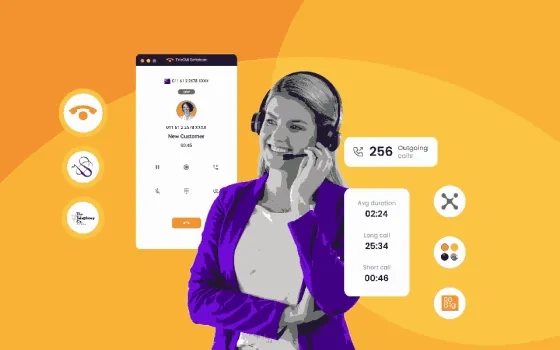Every business success is dependent on two main factors – retaining the existing customer base and making constant efforts to convert them into loyal customers. But in the whole process, the main challenging part is to engage with the customers, assess their levels of satisfaction/dissatisfaction, and the main reasons behind it.
Although there are numerous platforms available to interact with your customers and collect their valuable feedback, it’s difficult to keep track of their responses. This is why most of the businesses around the world employ CSAT or Customer Satisfaction surveys.
Objective of Customer Satisfaction Surveys
The objective of a Customer Satisfaction Survey is to keep a pulse on your customers by knowing their views that allow you to understand the pain points in your products and services and take appropriate action to enhance them that can further improve the overall customer experience. Moreover, this is what will set you apart from your competitors and help you win customers.
Top 10 Tips to Create Valuable Customer Satisfaction Surveys
Getting your consumers to respond to a Customer Satisfaction Survey might look like a daunting task. However, with the appropriate targeting and right set of questions, they’ll be more than willing to provide you in-depth insights that’ll help your business achieve targeted goals.
If you want to get the most out of your surveys, then you need to follow certain tips while creating CSAT surveys. Make sure that surveys are succinct enough to attract customers and compel them to take it in the first place. Let’s explore some of the best industry CSAT survey practices to ensure your next survey is a success!
1. Keep your Surveys Short
Do you know the main reason behind survey abandonment? Lengthy surveys.
If you want to get quality results, then keep your CSAT surveys short, which can capture maximum insights. Try to keep them clear and concise. Don’t include complex phrases in your questions.
It’s a good idea to capture every detail, but keeping a small list of questions can maximize the response rate. The main benefit is it won’t take long to complete the surveys. Using skip logic is another useful tactic that allows surveyors to answer questions that’re relevant to them.
Avoid asking ambiguous questions: “How would you rate our check-in process and staff.” Combining two questions in a single question can confuse customers. What if they’re happy with the check-in process but unhappy with the staff services? In such tricky situations, it would be difficult for them to choose the right answer.
“According to a study done by Versta, data quality declines on surveys that are longer than 20 minutes, so try to create a survey that takes no more than 15 or 20 minutes to complete.
2. Include Close-Ended Questions
A closed-ended question consists of pre-populated answer choices. Such type of questions asks surveyors to choose from a diverse set of predefined responses, such as “yes/no,” drop-down options, checkboxes, or among a multiple set of answer choices. Closed-ended questions are helpful to gather quantitative data from surveyors.
Example of a close-ended question: “Do you think adding additional features will make the product better”? Choose from the options below:
- Strongly disagree
- Disagree
- No opinion
- Agree
- Strongly Agree
3. Optimization of Survey Timing and Scheduling
The probability of getting a high-response rate for your survey is when you share it with the consumers at a time that’s suitable for them. Don’t try to send them surveys during work hours as they might be busy and less likely to respond. It’s an excellent strategy to send out a Customer Satisfaction Survey either at the beginning or end of the weekdays.
Now the next question comes- How often should you conduct surveys? Once in a year or once in a quarter? Every business is different, so they should conduct surveys based on their requirements. But, if you want to keep a pulse on your customers, then it’s a good practice to conduct them at least once in a month.
- In case of B2B surveys, Monday is a perfect day to survey your customers to get the highest amount of survey responses. In case of B2C surveys, Tuesdays, Wednesdays, and Fridays will have a relatively high response rate as compared to the rest of the days.
- Suppose if you run a restaurant, retail store, or any business having lots of employees working in different shifts, then the best way is to schedule surveys automatically with the help of a CSAT survey tool.
4. Optimization of Surveys for Mobile
Technology has advanced a lot. Gone are the days when people used to take surveys only on desktops. Nowadays, people perform every single activity from online shopping to booking movie tickets on their mobile phones. The main reason behind this is that it’s the most convenient and easily accessible medium.
People prefer to open emails and complete surveys on their smartphones & tablets. Thus, it’s essential to ensure that your surveys are mobile optimized and look good on mobile devices.
- Keep Multiple Answer Choices in Vertical Format: Try to keep your answer choices in vertical format for multiple-choice questions. Due to less space available on mobile phones, surveyors might not be able to see all the options. Moreover, try not to include answer choices in a drop-down, as it will be difficult for the surveyors to scroll down and see all the options.
- Don’t include Heavy Multimedia Files: If the phone is connected on a mobile network and the speed is slow, then it might take a huge amount of time for multimedia files to load. This is why make sure to include small multimedia files that are easy to load on smartphones. Before sending surveys to your customers, don’t forget to test them on both android phones and iPhones to check if all the features appear and work fine as per the functionality.
As per Statista, the number of Smartphone users worldwide has surpassed 3 billion and is forecast to further grow by several hundred million in the next few years.
5. Promote Surveys on Different Platforms
It’s essential to choose the right platform where your customers are present. With an effective survey distribution plan in place, you can determine all the important channels and accomplish pre-defined goals.
Try to choose a survey tool that can promote your surveys on multiple platforms. You can post a survey on the website, embed surveys in an email, send survey links via SMS, take surveys on iPad, tablets, kiosks via an offline survey app, or even encourage customers to fill it out on social media platforms.
Paid Social Media: With paid social media, you can expand your reach and target the right audience. You can run your surveys via Google Ads.
6. Avoid Asking Personal Questions
Not every customer might feel comfortable sharing their personal or sensitive information with you. It’s another reason why most of the surveyors abandon the surveys. Try not to ask people extremely personal questions. It might offend your customers and chances are high that you might land into legal battles. Try to include survey questions related to your business and usage of products or services.
- Let’s try to comprehend this with the help of an example, asking a personal question like “How was your experience with us on your 50th birthday?” could be an offensive question for a customer.
- Another bad example can be – if the employer is asking their employees questions related to their habits in a survey. No one will like it if you interfere in their personal space.
7. Offer Incentives
One of the most effective practices of CSAT Surveys is to reward your surveyors with an incentive in any form, a gift voucher, free upgrade to the latest version of the software, or even bonus or cash points and use them to redeem for gifts. These small efforts are a great way to increase response rates and show gratitude towards your surveyors for investing their valuable time.
- Offer Discounts: The best example of an incentive is a discount code for purchases or free shipping. The most effective incentives are where the customers can apply discounts to the order before the final checkout.
- Extend Subscription Period: In case of a SaaS product company, when it takes a lot of time to resolve your consumer’s issues and close a support ticket, then you can provide them additional services. You can even extend their subscription period to make them happy.
8. Provide Follow-up Surveys
Follow-up surveys can be used for different scenarios. For instance, you can use follow –up surveys in case of not completing a survey, immediately after an interaction with your products or services, after receiving a poor product or service review to know the reasons behind the rating.
- Use a Non-Responder Survey: In case of non-completion of surveys, you can create a short survey consisting of a single question and send it to your surveyors to remind them to take the survey. If possible, try to know the root cause for not completing the survey. You can include a question “I feel the survey is…”
o Boring
o Not Relevant
o Too Long
- Don’t Send the Same Survey to Everyone: This is one of the common mistakes that most of the businesses commit- sending the same survey to all consumers. You need to understand that different consumers will be at different stages of the consumer lifecycle. For instance, in the case of the travel industry, to gather in-depth feedback about the travel experience, you can send surveys after completing a travel trip.
9. Preview Your Surveys
Before sending out surveys to your surveyors, make sure they’re complete and appropriate. While creating a survey, there are chances that you must’ve forgotten to include some questions or answer choices. In either of the scenarios, your surveyors might leave the survey in between, and you won’t be able to capture the accurate data.
- Review Skip Logic: Review all possible paths where you can add skip logic. One single mistake can make your surveyors land up to the wrong page. Make sure that there should not be any programming error that can make them enter an infinite loop, and then it will be difficult to get out of it.
- Preview your Survey: To prevent any mistake in your survey design, first preview your survey. Try to share it with others so that they can find any errors and inform you to rectify them on time, which you might not be able to find on your own.
10. Add a Custom Thank You Note
It’s always a sweet gesture to thank all those surveyors who complete your survey. It doesn’t matter whether the feedback is positive or negative; they still deserve acknowledgment. It’s a simple gesture to let them know that you value your surveyors for their time and effort.
- Personalized Message: You can design a thank you note addressing your surveyors by their first name and send them with the survey. Thank them twice, once in the starting and second in the end. “Your feedback will help us enhance our products and services. Thank you for taking the time to complete the survey.”
- Customized Thank You Page: Once the surveyors complete the survey and click on the “Submit” button, you can display a thank you page. The message confirms that their response has been submitted, thank them for their time, and share any other relevant information.
How to Create and Distribute CSAT Surveys?
Apart from providing incredible products and services, it’s important for your business to keep your customers happy and satisfied. To keep them content, you need to ensure that they get what they want.
By gauging Customer Satisfaction, businesses can evaluate which areas of their product and services need improvement. This is why Customer Satisfaction Software has become a crucial asset for every business to evaluate if their customers had a good experience and left satisfied.
Conclusion
Conducting surveys on frequent intervals is a smart tactic which businesses should follow to gain feedback from the people who matter the most – your customers. If you include these CSAT survey best practices while creating a survey, then it can help you improve the survey response rates and get the most out of your customers.
















